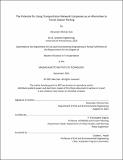| dc.contributor.advisor | Zegras, P. Christopher | |
| dc.contributor.author | Salz, Alexander Michael | |
| dc.date.accessioned | 2022-02-07T15:25:04Z | |
| dc.date.available | 2022-02-07T15:25:04Z | |
| dc.date.issued | 2021-09 | |
| dc.date.submitted | 2021-10-27T14:23:43.002Z | |
| dc.identifier.uri | https://hdl.handle.net/1721.1/140117 | |
| dc.description.abstract | Historically, transit agencies have prioritized sustaining existing Park and Rides (P+R) over further Transit Oriented Development (TOD), incurring high financial opportunity costs in the form of an “implicit” parking subsidy and foregoing potential ridership gains in the process. However, the widespread adoption of Transportation Network Companies (TNCs) like Uber and Lyft over the past several years presents a potential opportunity to change the tradeoff transit agencies face between P+R or TOD. This thesis explores the potential for transit agencies to utilize TNCs to reduce demand for transit station parking while decreasing transit agency subsidies and increasing ridership via a mechanism introduced as TNC and Ride or “TNC+R”.
Through a case study of the North Quincy MBTA Station in the Boston Metropolitan Area, this study conducts a financial analysis to quantify the implied P+R subsidy a transit agency incurs by requiring 1:1 parking replacement in an effort to retain all existing P+R users, in lieu of additional TOD revenue and ridership. The analysis estimates that the MBTA is incurring an implicit subsidy of $20 per current parked car in lieu of another 236,700 Square Feet of TOD.
Taking the calculated parking subsidy amount, I use ridership data for North Quincy Station to model the potential financial savings of subsidizing TNC rides instead of retaining parking spaces in certain situations. The modeling considers short term rider financial indifference between P+R and TNC+R. The financial analysis estimates that the MBTA could eliminate all of the 852 existing spaces at the North Quincy TOD site and still retain existing ridership through a lower-cost TNC+R subsidy. The subsidy would convert 469 daily P+R users who travel up to 13 minutes to the station to a TNC+R alternative. The switch to a TNC+R would allow the transit agency to net another $665,000 annually without any incumbent ridership losses. The average subsidy amount decreases by over 25% to $14.50 per round-trip. Finally, the thesis concludes discussing several ways and situations to best use a TNC subsidy. Because of their significantly different cost structures, using transit station parking and TNCs in tandem is generally the best approach and the best-suited stations are those with high land values and/or with a large number of park and riders that live a short distance to the station. | |
| dc.publisher | Massachusetts Institute of Technology | |
| dc.rights | In Copyright - Educational Use Permitted | |
| dc.rights | Copyright retained by author(s) | |
| dc.rights.uri | https://rightsstatements.org/page/InC-EDU/1.0/ | |
| dc.title | The Potential for Using Transportation Network Companies as an Alternative to Transit Station Parking | |
| dc.type | Thesis | |
| dc.description.degree | S.M. | |
| dc.contributor.department | Massachusetts Institute of Technology. Department of Civil and Environmental Engineering | |
| dc.identifier.orcid | https://orcid.org/0000-0002-1881-899X | |
| mit.thesis.degree | Master | |
| thesis.degree.name | Master of Science in Transportation | |
